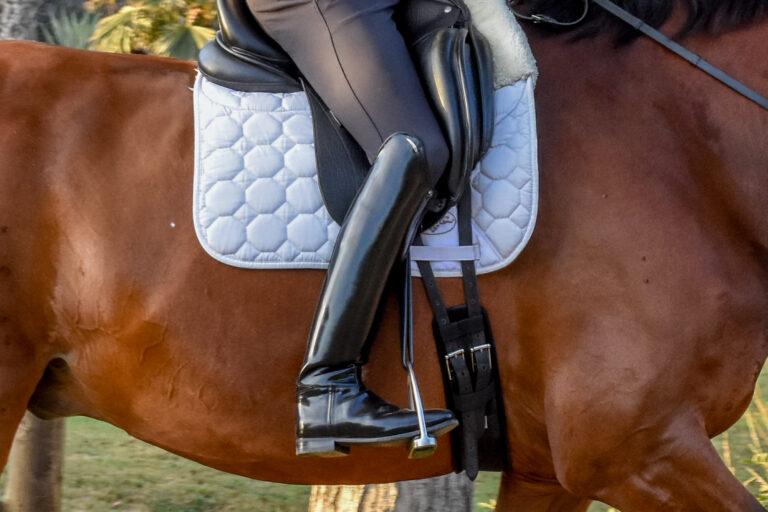
This is Hannah Jensen and her 7-yearold Shire/Dutch Warmblood-cross mare, Rosabella. The pair is showing First Level. Going from this snapshot, I can advise a few things.
I’d say that Hannah is generally in a good place with her body and how it’s affecting her mare. She is nicely on the vertical line with her upper body, neither leaning back nor forward.
However, the shape and consistency of her body could be made more effective. She’s slightly too hollow in her lower back, which you can see mostly in that her pelvis is tilting forward. It is a small amount, but I would suggest that Hannah engage her abdominal muscles, making them into a strong wall that keeps her insides farther back in her body. This will increase her strength as well as keep her pelvis from pushing forward like it does. More engaged abdominals will encourage Hannah to have stronger back muscles as well, and these muscle groups together will give her the strength to be on her horse’s back with a deeper effect.
Another aspect of Hannah’s upper body that is keeping her from that deeper effect is how she holds her shoulders and rib cage tightly upward. It looks as if she’s lifting her rib cage up and away from her pelvis and that takes strength away from her core and stability. I would like to see her lower her rib cage by trying to have a shorter distance between the top of her pelvis and the bottom of her rib cage.
Her shoulders need to be pulled more down by engaging her latissimus dorsi muscles so that her upper body can become more dense, stable and, in a sense, shorter. Trying to stretch up taller to look more elegant is not useful for athletic purposes. Many riders think they should sit up tall, but it almost invariably leads them into an incorrectly weak core and a stiff (not neutral) spine. The same goes for the length of your leg. Don’t lengthen you stirrups as if you’re inches taller than you are. It’s not effective and we see this happening to Hannah in the photo.
Hannah could use shorter stirrups for multiple reasons. First, her knee does not have enough bend and her lower leg has gone too far forward, which is also part of the reason that it has turned out. More bend in her knee would give her the leverage to stabilize her body during longitudinal transitions. There are lots of forces put on your body in stop-and-go transitions that you need the strength to match.
The second reason is the back of her calf is in too much contact with her mare’s side and her toe has pointed out. Ideally, her foot should remain more parallel with her mare’s side. Hannah’s thigh is in a good angle out of her pelvis and it is appropriately inwardly rotated to make a consistent contact with the saddle. However, her foot should be farther back so that it remains in a place directly under the straight line from her shoulder to her seatbone as if she were standing on the ground with her knees bent.
There’s a nice energy in her horse’s trot and a good contact. Hannah’s hands look solidly holding the rein, but not pulling, and her horse is happy to push from behind and accept the contact. I think with the slight changes I suggested for Hannah’s body, her horse will trot more freely, stepping through with the hind leg so that she tracks up better. In this photo, the mare is flexing her joints but forwardness is lacking. When Hannah has a stronger core and better angles in her leg, she will have the strength and leverage to really match the forward forces she asks her mare to have. Otherwise, I think she’s in a position to get left a bit behind.











